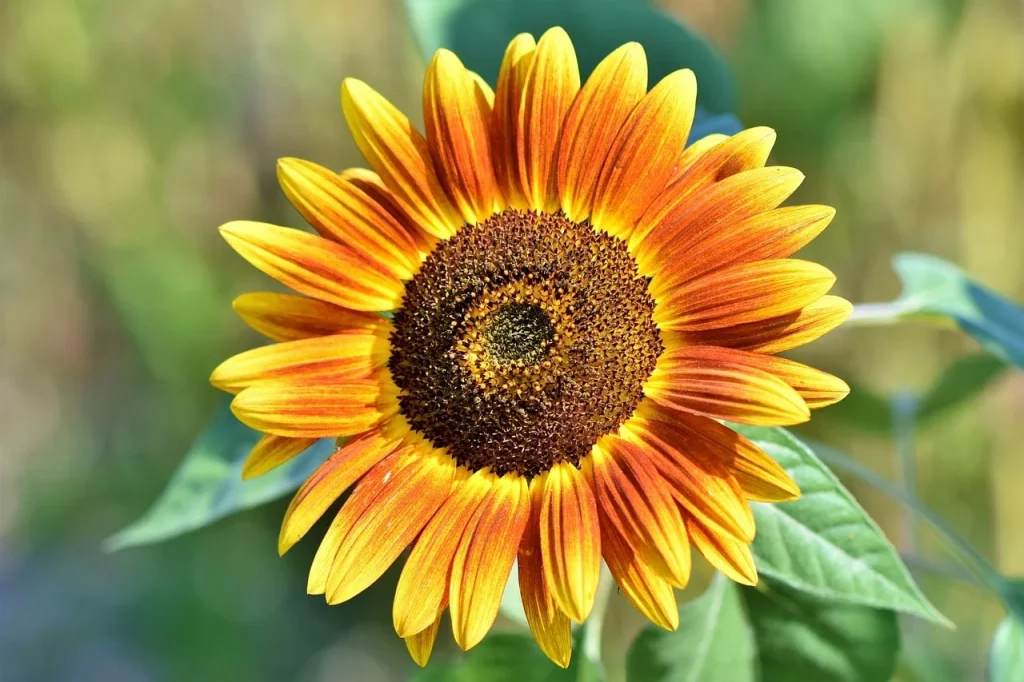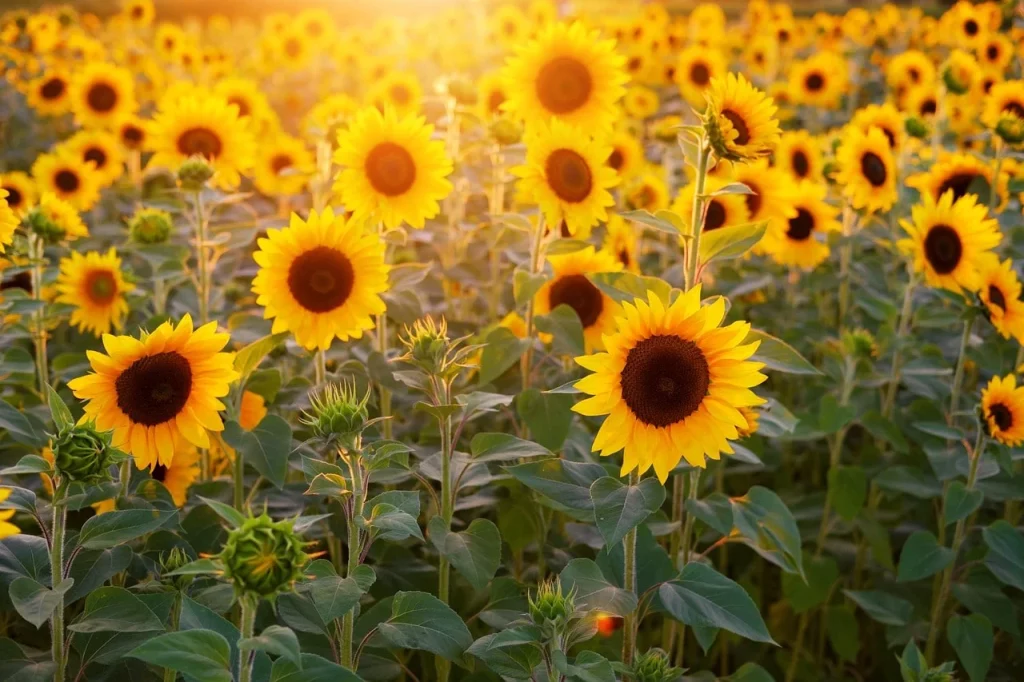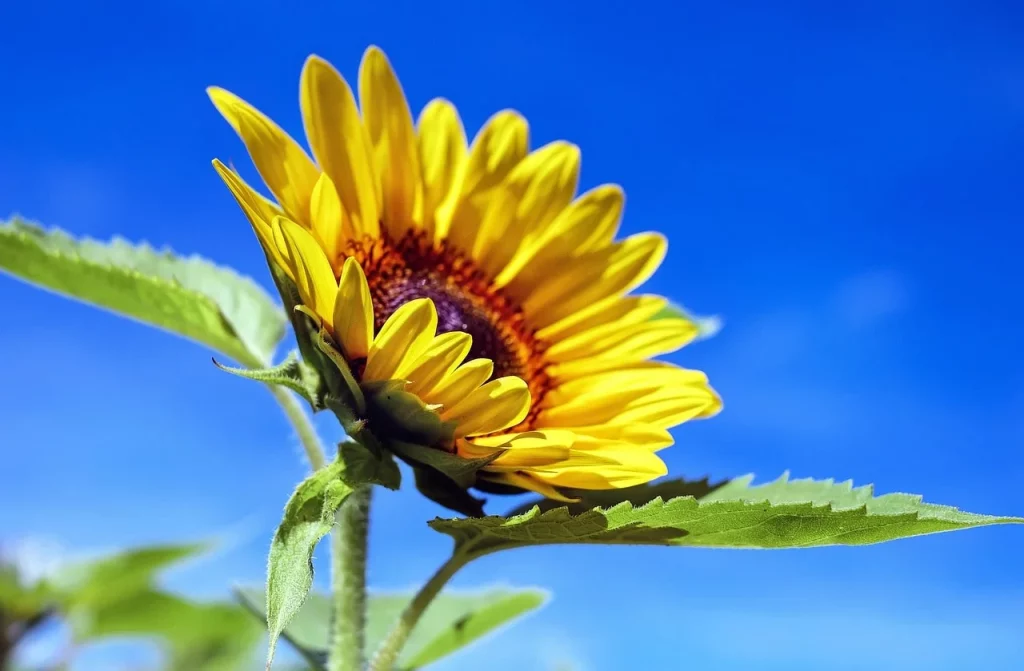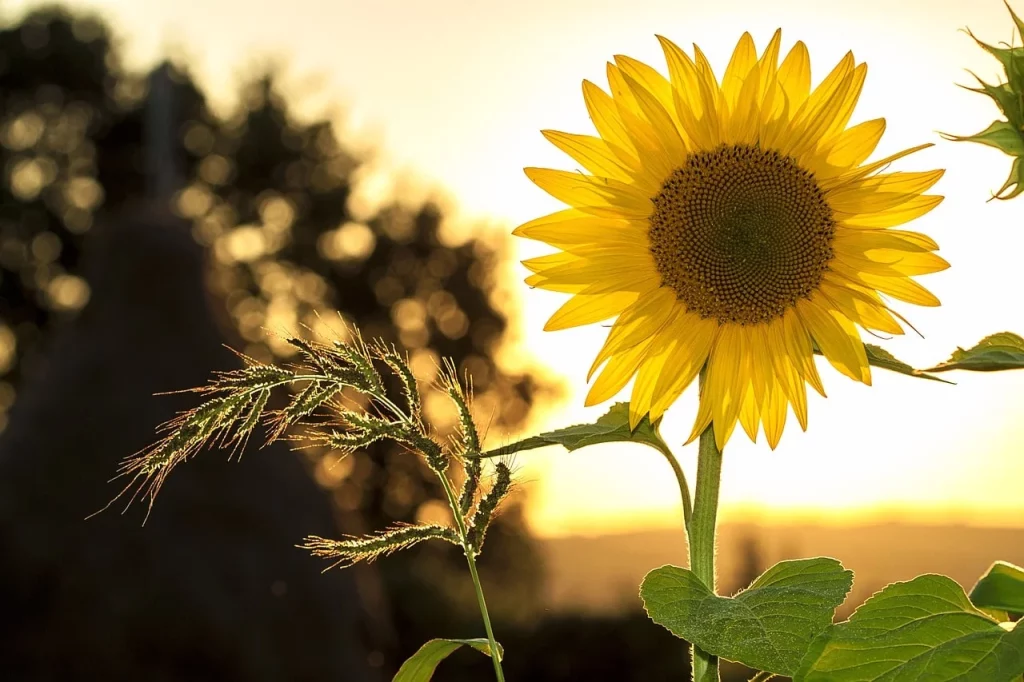Sunflowers, with their bright and cheerful faces, are more than just a pretty sight in gardens and fields. They hold a myriad of fascinating secrets and incredible facts that might just surprise you.
Have you ever wondered what makes these radiant flowers so unique and beloved around the world? In our journey through these interesting facts about sunflowers, we’re about to uncover the extraordinary world of them, revealing why they deserve a special place not just in our gardens but also in our hearts.
Sunflowers end up facing the sun, but they go through a lot of dirt to find their way there.
J.R. Rim
Sunflower Facts
Let’s start our journey. Keep in mind that I created a quiz about sunflowers at the end of the article. So read each fact carefully, as your knowledge is going to be tested later on. Don’t disappoint me.
- The Latin name for sunflowers is Helianthus annuus.
- Originating in North America, sunflowers are now cultivated globally.
- Studying sunflowers is referred to as Helianthology.
- Known for their prominent heads, sunflowers have bright yellow petals.
- A sunflower’s head comprises numerous smaller blooms.
- Heliotropism describes a sunflower’s ability to follow the sun.
- Sunflowers face east at dawn and rotate westward by dusk.
- The record height for a sunflower exceeds 30 feet.
- Not only are sunflower seeds edible, but they’re also used for oil extraction.
- Sunflower petals vary in color, from yellow to red hues.
- Phytoremediation uses sunflowers to decontaminate radioactive soil.
- A sunflower’s root system can extend up to 6 feet deep.
- Up to 2,000 seeds can be found in a single sunflower.

- Sunflowers are a source of vitamins E and B1, as well as minerals like copper and selenium.
- During the 16th century, Europeans were first introduced to sunflowers from the Americas.
- Traditional medicine employs sunflowers for their anti-inflammatory benefits.
- Sunflower seeds are arranged in spiral configurations.
- Famous for his sunflower paintings, Van Gogh created several iconic works featuring them.
- Sunflowers represent loyalty, adoration, and longevity.
- The edible part of a sunflower seed is called the kernel.
- The detoxifying properties of sunflowers enable them to extract arsenic and lead from soil.
- Sunflowers are often associated with prosperity and energy in various cultures.
- Ukraine stands as the leading producer of sunflower oil globally.
- Used as colorants, sunflower petals are implemented in dyeing fabrics and foods.
- Bees and butterflies are drawn to sunflowers for their nectar and pollen.
- Wild sunflowers adapt well and thrive in various climates.
- The plant’s stems are used in the production of textiles and paper.
- Two types of flowers make up a sunflower’s head: ray and disk flowers.

- Native Americans have utilized sunflowers for over 5,000 years.
- Animal feed and compost are two uses for sunflower seed husks.
- Sunflowers have a unique property of radiation absorption.
- The sunflower sector significantly contributes to agricultural economies worldwide.
- Low in saturated fats, sunflower oil is rich in polyunsaturated fats.
- The largest sunflower field, according to Guinness World Records, contained over 600,000 plants.
- Water pollutants can be removed using sunflowers in bioremediation processes.
- Fibonacci sequences dictate the arrangement of seeds in a sunflower’s head.
- As annual plants, sunflowers complete their lifecycle in a single year.
- The leaves of sunflowers are characterized by their rough and hairy texture.

- Sunflower honey is prized for its unique taste.
- Aside from cooking, sunflower oil is a component in cosmetic products such as lotions.
- Biomineral extraction, such as metal recovery from soil, utilizes sunflowers’ absorptive qualities.
- In “One Day in the Life of Ivan Denisovich,” Solzhenitsyn used a sunflower as a symbol of hope.
- Natural pest resistance is a notable trait of sunflowers.
- The introduction of the Argentine sunflower to Russia in the 18th century transformed their agricultural practices.
- Sunflower petals and other plant parts are edible, often found in salads and teas.
- Varieties of sunflower seeds display either black or striped patterns.
- Rich in magnesium, sunflower seeds support heart health.
- Due to their vibrant color, sunflowers are a favored subject for artists.
- Oil, seeds, and dyes were some of the uses Native American tribes had for sunflowers.
- Known for their resilience, sunflowers can grow in suboptimal soil conditions.
Sunflower Myths

After reading all these fun facts about sunflowers, we now move on to the next section. It’s time to bust some popular myths about these yellow flowers.
- Sunflowers Always Face the Sun
Adult sunflowers don’t follow the sun. While young sunflower blooms, known as “heliotropic heads,” do track the sun from east to west during the day, mature ones generally face east. This eastward orientation maximizes morning sunlight and helps attract more pollinators. - Sunflowers Are Always Yellow
They come in a variety of colors! While the classic image is of a bright yellow bloom, sunflowers can also be found in shades of red, orange, brown, and even purple. Breeders have developed many unique and striking varieties. - Sunflowers Are Just Beautiful Flowers
They’re not just pretty faces! Sunflowers are incredibly useful. Their seeds are edible and nutritious, used for producing sunflower oil, and the plants are great for bees and other pollinators. They also have phytoremediation properties, meaning they can extract toxic ingredients from the soil. - Sunflowers Grow Only in Summer
They are indeed summer bloomers, but their seeds can be planted in late spring to early summer. Depending on the variety, some sunflowers can bloom into early autumn, offering a longer period of beauty and utility in a garden. - Sunflowers Are High Maintenance Plants
They are actually quite hardy and low maintenance. They thrive in full sun and can tolerate drought. They’re not very picky about soil and don’t require much in terms of fertilization. This resilience makes them a favorite among gardeners of all skill levels.
No products found.
Sunflower Quotes

Sunflowers, with their vibrant golden petals reaching towards the sun, have long been a source of inspiration and wonder. Here is a list of my favorite quotes about them. Let me know yours in the comments so I can add them to the list.
Keep your face to the sunshine and you cannot see the shadow. It’s what sunflowers do.
Helen Keller
Helen Keller uses the sunflower as a symbol of optimism and focus, encouraging people to concentrate on the positive aspects of life, much like sunflowers turning towards the sun.
The road to freedom is bordered with sunflowers.
Martin Firrell
Martin Firrell metaphorically depicts sunflowers as symbols of hope and freedom, suggesting that the path to liberation is lined with beauty and positivity.
Does she realize she looks like a sunflower, ready to rain sunlight on all who look down upon her?
Simone Elkeles
Simone Elkeles, in this quote, beautifully compares a woman’s radiant and uplifting presence to that of a sunflower, which exudes brightness and positivity.
Sunflowers are like people to me.
Joan Mitchell
Joan Mitchell personifies sunflowers, suggesting a deep connection and similarity between the flowers and human beings, perhaps in their shared need for light and growth.
Big doesn’t necessarily mean better. Sunflowers aren’t better than violets.
Edna Ferber
Edna Ferber in this quote, emphasizes the beauty and value in all things, regardless of their size, comparing the grandeur of sunflowers with the modest charm of violets.
Sunflower FAQ

We are reaching the final section (the quiz), but before that, here are some popular questions about sunflowers that I found online. Prepare for the ultimate test just ahead.
- How do sunflowers bloom under moonlight?
Interestingly, sunflowers don’t really bloom under moonlight. They rely on sunlight for their growth and blooming processes. During the night, they don’t actively bloom, but they can appear to be open if they bloom during the day. The charm of moonlit sunflowers is more poetic than botanical! - Can sunflowers grow indoors?
Yes, they can! If you have a sunny spot in your home, you can grow sunflowers indoors. They need about 6 to 8 hours of sunlight per day, so a window that gets plenty of light is essential. Smaller varieties are better suited for indoor growing due to space constraints. - Are sunflowers edible?
Absolutely! Sunflower seeds are the most commonly eaten part and are packed with nutrients. You can eat them raw, roasted, or use them in various recipes. Sunflower oil is also widely used for cooking. However, other parts of the sunflower plant are less commonly eaten. - Are sunflowers toxic to cats?
Good news for cat owners: sunflowers are not toxic to cats. They’re actually one of the safer plants to have around pets. However, as with any plant, it’s always best to keep an eye on your pets to ensure they don’t chew on the plants excessively. - Can sunflowers grow in pots?
Yes, sunflowers can thrive in pots, especially the smaller varieties. Make sure to choose a pot that’s large enough to accommodate the root system and provide adequate support as the plant grows tall. Regular watering and a sunny spot are key to keeping your potted sunflower happy and healthy.
No products found.
Sunflower Trivia

Welcome to our sunny sunflower quiz! But be warned, if you don’t get any answers right, you might just turn into a sunflower yourself – stuck staring at the sun all day!
Conclusion
Sunflowers, with their cheerful disposition, often evoke memories of summer days and childhood innocence. They remind us of the unadulterated joy found in nature’s creations. Think back to your earliest memory of a sunflower. Did it make you smile then, just as it does now?
Let’s close this adventure with a funny question: If sunflowers ran for president, what would be their main campaign promise? Let me know your funny ideas in the comments.


